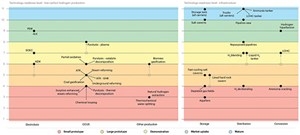Articles
Developing electrolyzer technology is a key component for the future of H2 energy
EDITORIAL COMMENT
Tyler Campbell, Managing Editor, H2Tech
On August 22, 2022, U.S. President Joe Biden signed the Inflation Reduction Act. This legislation boasts $369 B in climate and clean energy investments with a focus on clean H2, and it offers a clean H2 tax credit for H2 projects and storage technologies. The act is the most ambitious climate-focused legislation ever passed by the U.S. Congress.
According to Gulf Energy Information’s Global Energy Infrastructure database, 100 of the more than 700 H2 projects in either the planning stage or under construction are in the U.S. These projects are mainly in Texas, Louisiana and California, with the majority being green and blue H2 projects. The blue H2 projects, which use carbon capture and storage, will be eligible for a tax credit, with additional tax incentives offered to facilities that utilize the captured carbon.
The future of H2 energy. There is still much improvement needed to completely integrate H2 into the global energy mix and meet global climate goals of net-zero emissions by 2050. To accomplish these ambitious initiatives, 2030 will be the first milestone. According to the International Energy Agency’s (IEA’s) Hydrogen Supply Report, in 2021, low-emissions H2 production was approximately 0.6 MMt.1 For the 2050 targets to be reached, low-emissions H2 production must be increased to 95 MMt by 2030.
Low-emissions H2 production technology must be rapidly progressed to reach this milestone. Electrolysis is a promising method to produce green H2, but each type of electrolyzer is in different stages of advancement.
According to the IEA, proton exchange membrane and alkaline electrolyzers are at the market uptake level, solid oxide electrolyzer cells are still under demonstration and anion exchange membrane electrolyzers are still at the prototype level (FIG. 1). However, these technologies are not yet competitive with gray H2 production technologies. Developing green H2 production technologies will be essential to the future of H2 energy.H2T

LITERATURE CITED
1 International Energy Agency, Hydrogen Supply, 2022, online: “https://www.iea.org/reports/hydrogen-supply

